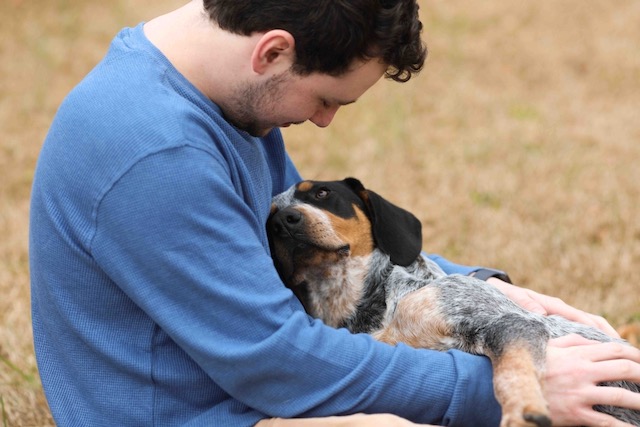One of the hardest parts of being a pet owner is seeing your furry baby in pain. When you do, you might wonder if you can give human pain medication to dogs. It can also be hard to know if they are in pain. Let’s dive into this topic and get your pup on the road to recovery.
How to tell if your pup is in pain
Unlike humans, dogs can’t tell us when something’s hurting. On top of that, many dogs have a high pain tolerance and won’t show signs of discomfort even if they are in terrible pain. You know your pet better than anyone, so here are some signs to watch for if you suspect your dog is hurting.

- Unusually anti-social: If your pup typically runs to greet you or others at the door but suddenly seems not to care, this could be a sign they are in pain. Dogs are pack animals, and when they begin to deny themselves the pleasure of being around their pack — which includes you — it’s a red flag.
- Changes in eating or drinking: If your dog has gone many days without eating (and it’s unusual for them), you may want to take them to their vet to get checked out.
- Not sleeping well: If you’re noticing them walking around the house at night or tossing and turning, or just standing at the foot of your bed, this could be cause for concern.
- Unusual vocalizations: Barking, howling, growling, whining, and yelping could all be ways your dog is trying to tell you that something isn’t right. These vocalizations typically happen during walks, feeding times, or playtime. If your dog is talking to you, listen.
- Excessive licking: Licking can be a dangerous symptom of pain if not noticed in time. Just as people might rub a bumped head, dogs can lick the parts of their bodies that hurt. Although this can be a great way for you to identify a problem, your pup could lick themselves raw and cause infection if unnoticed.
- Breathing or panting heavily: If your pup is panting or breathing heavily when they have not been exercising, this could be a sign of pain. Panting is normal for many dogs, but excessive or nonstop panting is something to watch out for.
- Moving around less: A typically rambunctious and energetic dog suddenly lying around or avoiding movement is another sign that your pup might be in pain. Stiffness or limping is an obvious sign that they might be injured. If your puppy is reluctant to jump into your lap, take them to see a vet.
- Unusual aggression: This uncharacteristic behavior can present itself during mealtime, playtime, or snuggle time — a dog that suddenly begins growling while being petted could be a dog in pain.
- Changes in posture or body: Internal pain can sometimes present itself in a change of posture. Your dog could hunch their back or hold up a paw or hang their head if something feels off.
- Trembling or shaking: Although some smaller dogs shake and tremble from habit, many times this can also mean they are in pain. If your pup shakes or trembles as they sit on your lap or while you’re petting them, it’s a good idea to get them checked out.
What to do if your pup is in pain
You think your dog might be in pain; what do you do now?
- Begin by noting your pup’s symptoms on your phone or a notepad. Bringing that information to a vet visit will help you and your veterinarian identify what could be the problem.
- Set up an appointment for your pup to see their vet. Even though there are many sources of information on diagnosing dog pain, it is always safest to consult your pet’s veterinarian before doing anything else.
- After your vet has diagnosed your pet’s condition and provided medication to help, it’s critical to give the prescribed medicine exactly as your vet instructed. The best way to get your pup back to normal is to follow a veterinary professional’s instructions.
Until you get to your appointment, here are several ways you can help alleviate some of the pain your dog may be experiencing.
- Limit their activity and movement.
- Provide a soft, comfortable bed.
- Eliminate stressors such as loud TVs or rowdy children.
- Give them gentle petting and massages.
- Keep them company; loneliness can cause stress and inhibit your dog’s ability to relax.
Following your vet’s instructions and these tips will be the best way to get your pup back to their usual self.
Should you give your pup human pain meds?
The short answer is no. Although some human over-the-counter pain medications are not likely to harm your pet, without proper dosage, giving your dog pain meds from your cabinet can be extremely dangerous. Often, giving pups human medication can lead to vomiting, diarrhea, stomach ulcers, kidney failure, and more.
If your dog is experiencing pain, the best thing you can do for them is call their doctor and get them in for an appointment as soon as possible. Until then, give them lots of love and a soft place to lie. Then follow the vet’s instructions to a T to ensure a fast recovery for your furry baby.
If you’d like to know more about your puppy, you can check our guide on when you should give your puppy a bath.
Editors' Recommendations
- Why does my dog have a bald patch on their tail? Here are the answers you need
- Looking for signs your dog has ticks? These telltale symptoms mean you have a flea or tick problem
- Xylitol is dangerous for dogs: 10 surprising products that contain it as a hidden ingredient
- Here’s how to treat a dog with itchy paws, starting with finding the cause of paw discomfort
- What is the best food for older dogs? These 6 vet-approved kibbles and canned foods won’t steer you wrong



